Note: This website was automatically translated, so some terms or nuances may not be completely accurate.
What Makes the Difference in "Popularity"? ~ Considering "Food and Romance"
This marks the fifth installment of the Food Lifestyle Lab (commonly known as Food Lab) series. This project aims to explore food from a slightly broader perspective than usual, under the theme "Considering 'Food and XX'".
This installment focuses on "Food and Romance."
Historically, dining settings have often served as venues for romance. Research by American psychologist Gregory Lazzaroni demonstrates that sharing a meal and conversation with someone links the pleasure derived from the delicious food to the person and the conversation itself, increasing feelings of affection toward that person.
This strong connection between "food and romance." How does the relationship between food and romance vary by generation, considering the "shifting attitudes toward food" introduced in previous installments and the changing "attitudes toward romance" in modern times, where forms of meeting and gender dynamics are evolving? We'll examine this by generation.
This time, we'll explore these aspects while unraveling the role of food.
Do "attractive" food preferences differ across generations!?
The characteristics of "attractive" people change significantly as generations shift. This time, we'll examine what food-related traits "attractive people" possess compared to "unattractive people," breaking it down by generation.
We'll again use data from the "Dietary Habits Lab Survey Vol. 5"* for our analysis.
This analysis will explain the differences in dietary attitudes between two groups: the "romantically fulfilled" who answered "I think I'm attractive to the opposite sex" and the "romantically unfulfilled" who answered "I think I'm not attractive to the opposite sex," broken down by age group ("10s-20s," "30s-40s," "50s-60s") and gender.
Incidentally, the percentage of people who think they are popular with the opposite sex is around 30% across all gender and age groups, making them a somewhat small minority. It seems that the younger the age group, the fewer people who think they are popular.
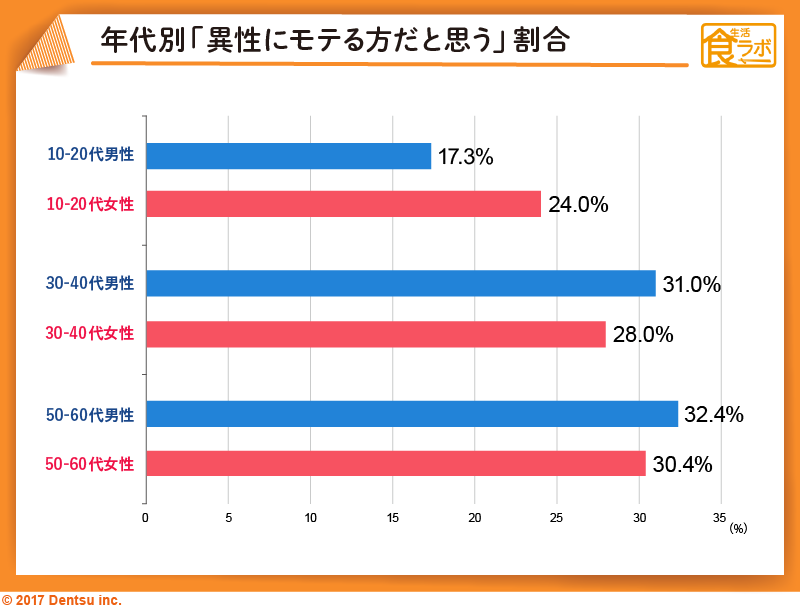
"Loving to cook" is still the ultimate dating technique
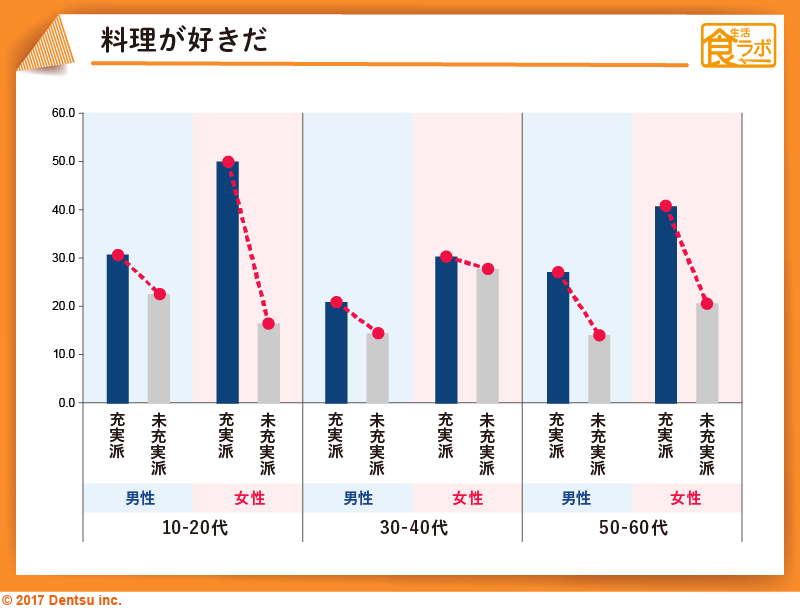
First, let's look at the common tendencies among the fulfilled group across all genders and age groups. Home-cooked meals have long been considered the ultimate attraction technique, and indeed, many in the fulfilled group seem to think, "I like cooking." Regardless of gender or age, those who enjoy cooking appear to have satisfying romantic lives in any era.
Below, we'll examine age-specific attitudes among the fulfilled group to identify the "essential food awareness needed for fulfilling romance," even if these aren't universally shared across all age groups.
For those in their 10s and 20s, "Refined Food Communication Skills" are Key
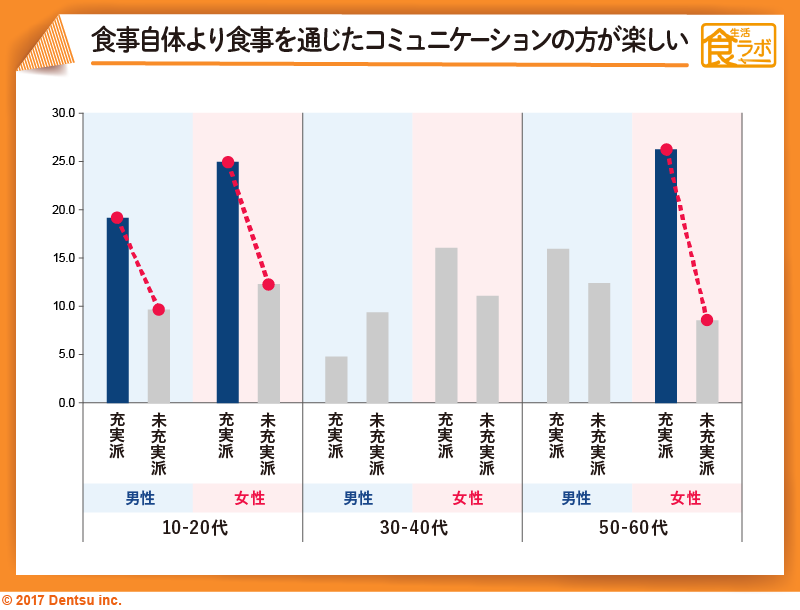
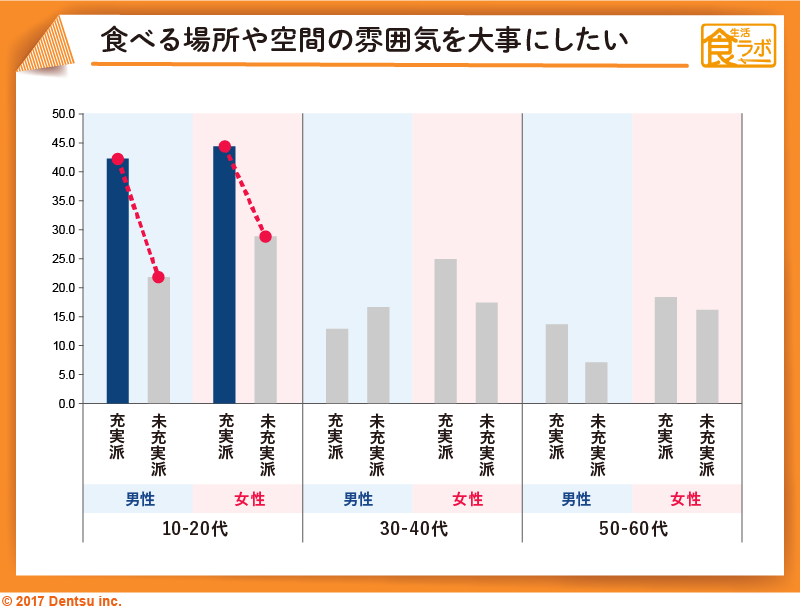
The graph compares the food-related attitudes of fulfilled and unfilled individuals across each gender and age group. Attitudes such as "Communication through meals is more enjoyable than the meal itself" and "I value the atmosphere of the place and space where we eat" are characteristically high among fulfilled men and women in their teens and twenties.
This tendency, strongly seen in this age group, is considered a necessary mindset for feeling that "love is fulfilling."
Indeed, compared to other age groups, those in their teens and twenties frequently use dining occasions like group dates as opportunities for romance. The difference between the fulfilled and unfilled groups likely stems from their ability to pay attention not just to the food itself, but also to the communication during meals and the surrounding environment.

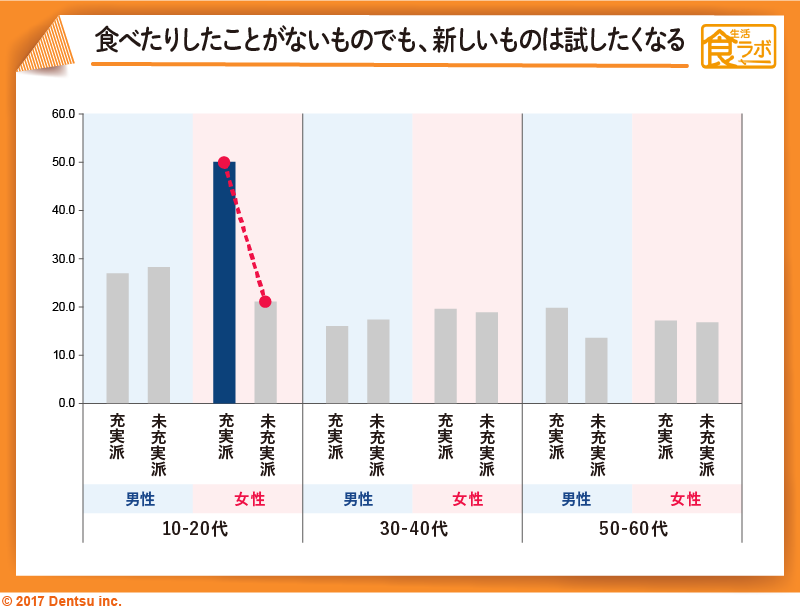
Among men in their teens and twenties, a particularly strong characteristic of the fulfilled group is the belief that "eating alone is lonely." Surprisingly, men who feel lonely eating alone tend to feel their romantic lives are more fulfilling.
Indeed, those with a more sensitive personality tend to initiate more opportunities to invite others to eat together. This increased frequency of such opportunities may ultimately lead to a more fulfilling romantic life.
On the other hand, a characteristic mindset unique to fulfilled women in their teens and twenties is "I want to try new things, even foods I've never eaten before."
The reason women who actively seek out new foods tend to be more fulfilled is likely because those enthusiastic about novel culinary experiences have more opportunities for conversation. They share their dining experiences and the meals themselves with others, increasing their chances for communication, including with members of the opposite sex.
In any case, for those in their teens and twenties, viewing food as a "communication space" and maximizing opportunities for such interaction appears to be a crucial factor for both men and women in becoming fulfilled individuals.
For those in their 30s and 40s, "caring for others while enjoying rich flavors" is key

A common characteristic observed among fulfilled individuals in their 30s and 40s is a preference for "rich, hearty flavors." While purely speculative, the background for why those in their 30s and 40s who like rich, hearty flavors tend to be fulfilled individuals might be that people who enjoy hearty flavors are often more energetic and proactive in romance.
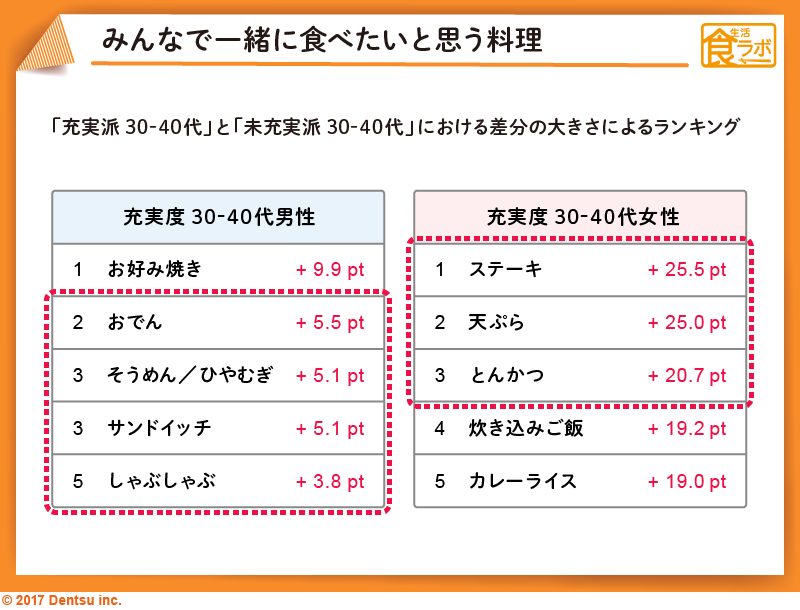
We'll now rank the dishes that these rich-flavor-loving, fulfilled individuals in their 30s and 40s "want to eat with others," focusing on those showing the largest difference compared to the non-fulfilled group. Examining this reveals what kinds of dishes these rich-flavor-loving, fulfilled men and women characteristically choose when dining with others.
Looking at fulfilled women, hearty dishes like "steak," "tempura," and "tonkatsu" dominate the top spots.
In contrast, among fulfilled men, lighter dishes like "oden" and "somen noodles" appear higher on the list.
While both men and women in the "fulfilling" category shared a preference for rich flavors, why did such a significant difference emerge in their food choices when dining with others?
This question might become clearer if we imagine the scene. When dining together with a mixed group, even if the meal is a hearty dish like yakiniku or tonkatsu—which men tend to prefer—if the women join in and enjoy it, it creates a sense of ease and comfort. This can lead to finding the other person attractive.
Conversely, for men, even if they personally prefer rich flavors, those who show consideration by suggesting "lighter meals" for the group to enjoy together are likely seen as attractive.
For those in their 30s and 40s, while a shared preference for rich foods exists, the ability to show consideration for others during meals seems to be a key factor in being attractive.
For those in their 50s and 60s, "daily food preferences" are important
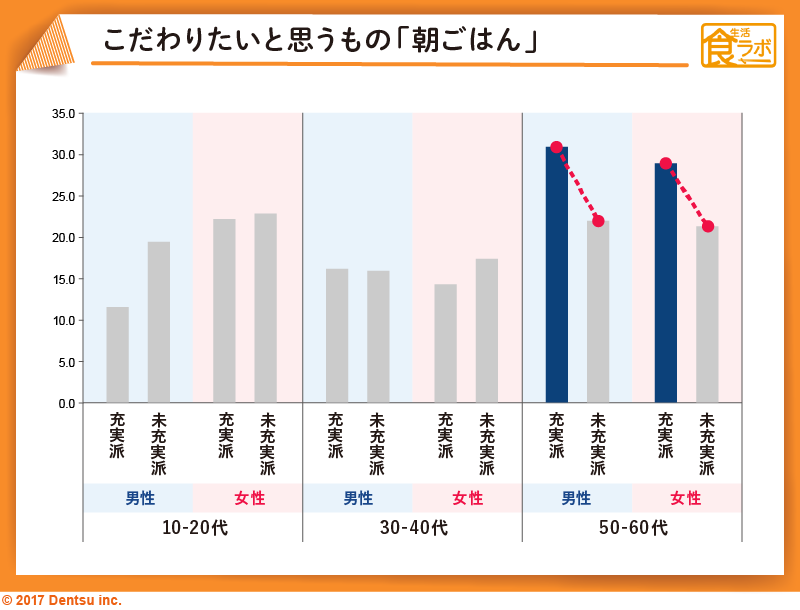

For fulfilled individuals in their 50s and 60s, many show strong dedication not to special meals eaten with others, but to everyday eating experiences like "breakfast" or "drinking at home."
Considering gourmet dining is a trend among those in their 50s and 60s, it makes sense that individuals who maintain strong daily food habits within this trend tend to have more fulfilling romantic relationships.
As seen above, we've examined age-specific dietary attitudes crucial for fulfilling romantic relationships, revealing distinct characteristics across generations. Re-examining food through the lens of romance might offer a slightly different perspective when appealing to each age group.
This series began with the idea of rethinking food not just as a standalone category, but through a broader lens incorporating perspectives from different fields and domains. Each installment has explored significantly different content, hasn't it?
The "Food and XX" perspective we've used to examine food is just one example; I believe there are infinitely more such perspectives. I look forward to continuing to explore "Food and XX" together with all of you.
Notes*<Survey Overview>
・Title: Food Lifestyle Lab Survey vol.5
・Survey Method: Online Survey
・Survey Participants: 1,200 individuals aged 15–79
・Survey Period: September 2016
・Survey Company: Video Research Ltd.
Was this article helpful?
Newsletter registration is here
We select and publish important news every day
For inquiries about this article
Back Numbers
Author

Sota Kato
Dentsu Inc.
Second Integrated Solutions Bureau
Planner
Responsible for planning and business creation based on marketing analysis across various sectors including food, automotive, daily necessities, and B2B.



